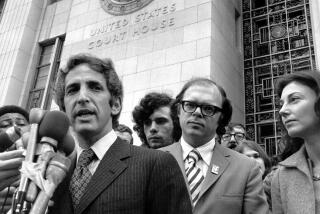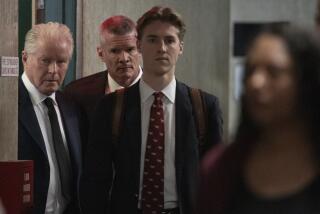Mormon Papers Case Guilty Plea : Hofmann Admits Killing to Conceal Forgeries
- Share via
SALT LAKE CITY — A rare-documents dealer whose alleged discoveries once threatened to undermine official Mormon Church history pleaded guilty Friday to forging documents and then killing two people to prevent his exposure.
Mark W. Hofmann, the documents dealer, was immediately sentenced by Utah U.S. District Judge Kenneth Rigtrup on two counts of second-degree murder and two counts of theft by deception. The sentences, which will be served concurrently, range from five years to life.
During the sentencing Rigtrup characterized the bombing murders of a Hofmann associate and the wife of a local businessman as “indiscriminate.” He said he would recommend that the 32-year-old dealer “remain incarcerated for life.”
Hofmann, who appeared at the court in a blue pinstripe suit, declined to make a statement and merely answered “guilty” to each of the four charges. He was immediately taken to Utah State Prison.
The guilty plea, which had been rumored here for weeks, was entered as part of a complex negotiation with prosecutors that allowed Hofmann to avoid a trial. Had he been found guilty at trial, Hofmann could have received the death penalty.
The court hearing on Friday appears to end a 15-month investigation that began as a sensational and baffling mystery. In October, 1985, two pipe bombs exploded and killed Steven Christensen, 31, and Katherine Sheets, 50, the wife of Christensen’s former business partner.
Several days later a third bomb went off inside Hofmann’s sports car, leaving him seriously injured. While first regarded as another intended victim, Hofmann, who has since recovered from his injuries, was soon identified by police as the prime suspect in the murders.
Hofmann, police said, had committed the murders in a desperate attempt to conceal a series of forgeries and frauds. Up to that point, Hofmann’s career as a collector and dealer in rare documents seemed to be on a meteoric rise. Over the preceding five years he had produced a series of early Mormon papers that had at first pleased and then alarmed church officials.
Hofmann claimed that the purported documents were the fruits of his searches throughout the nation. Although he produced dozens of secular letters and papers as well, the most dramatic involved the 19th-Century founding events in Mormon history.
History Contradicted
One such document, which became known as the white salamander letter, was allegedly written by an early disciple of Mormon founder Joseph Smith. The letter seemed to contradict official church history regarding Smith’s discovery of the golden plates, the most sacred event in Mormon history.
Among other things, the letter suggested that Smith’s discovery of the plates involved the appearance of a white salamander, a common folk-magic symbol. Official Mormon history is that Smith was led to the golden plates, which instructed him to found the church, by an angel named Moroni.
Later, Hofmann claimed to have located a long-lost set of papers known as the McLellin collection. That collection was also believed to contain evidence of character faults in Smith, including drunkeness and adultery. Hofmann had been seeking financial backing from Christensen to acquire the McLellin documents when the bombings began.
Immediately after Hofmann was identified as the prime suspect in the murders, high church officials held the first press conference in their history to reveal that several church officers had been involved in extensive negotiations with the dealer concerning a number of Mormon documents.
Prominent Members
Among the Mormon officials involved were Gordon B. Hinckley, the chief operating officer of the church, and Hugh W. Pinnock and Dallin Oaks, both prominent members of the church’s General Authorities.
Although repeatedly denied by church officials, critics have accused the church of trying to acquire the threatening documents so they could be kept from public view in the vaults of the church archives. Some have also suggested that Hofmann cynically exploited the church’s fears by producing ever-more threatening papers at ever-higher prices.
On Friday, Hofmann admitted in court that the salamander letter was a forgery and that the McLellin papers never existed. Prosecutors dropped 24 other counts of fraud involving allegedly false documents.
In a press conference following the hearing, prosecutors said that part of the plea-bargain would permit them to “debrief” Hofmann over the next 30 days. Hofmann will answer “all inquiries” into his activities, including those in the dropped charges, according to David Yocum, Salt Lake County attorney.
Yet some here said the plea bargain would likely leave some questions unanswered forever. “A trial would probably have told us a lot more about the involvement of the church with Hofmann and the documents,” said Sandra Tanner, one of the founders of the Utah Lighthouse Ministry, a Protestant group that often finds itself at odds with the Mormon Church.
Hand of Church
Saying she did not personally believe the church was involved criminally, Tanner said: “There are many who will see the church’s hand in the plea-bargain arrangement. This (the plea bargain) means that church officials will not have to appear on the stand and answer questions under oath.”
In a prepared statement, church spokesman Richard P. Lindsay denied that any influence was exerted on law enforcement officials to accept a plea bargain. “Church leaders were not involved and not consulted in the plea bargain,” he said.
Calling the church a “victim” of Hofmann’s activities, Lindsay said the church acquired a total of 48 documents from the dealer, mostly through trades. Seven of the 48 documents were purchased at a cost of $57,100, he said.
The Mormon Church claims 6 million members worldwide, incuding 4 million in the United States.
According to the police scenario put forward at the preliminary hearing last April, Hofmann felt cornered by his own forgeries and murdered Christensen in the fear that Christensen would expose him.
For several years Christensen had been involved with Hofmann in acquiring some of the Mormon artifacts. Previously Christensen had paid $40,000 for the salamander letter and was helping the collector find $185,000 for the McLellin collection.
Vouching for Reputation
Church elder Pinnock also helped by vouching for Hofmann’s reputation in an application for a short-term loan needed to complete the acquisition.
But on the day that Hofmann was supposed to meet with Christensen and produce the McLellin documents, a package exploded as Christensen picked it up outside his office. Christensen died immediately.
Shortly afterward, a second bomb killed the wife of Christensen’s former business partner Gary Sheets. Police argue that this killing was intended to suggest that the bombings were the result of a business dispute, thus diverting investigators away from Hofmann.
In all, police say, Hofmann fraudulently collected about $944,000 in the last months before the murders. Most of that money went to pay previous creditors in what one investigator called a “document Ponzi scheme.”
During the preliminary hearing, investigators revealed that during a search of Hofmann’s home, they had discovered receipts for electronic devices similar to those used in construction of the bomb. The receipts wer signed by “Mike Hansen,” an alias that investigators say Hofmann often used.
But the most dramatic testimony involved the discovery of the document forgeries. Previously the documents had been certified as authentic by a number of experts, including the FBI and the Library of Congress.
New Techniques
Using new techniques, document examiners discovered a characteristic cracking in the ink of virtually all the Hofmann papers. The cracking was eventually related to the artificial aging process Hofmann used on the documents.
County attorney Yocum said the techniques developed in the case likely will set a precedent for future document examinations. “We made some important contributions; you will hear this case referred to in the future,” he said.
In spite of Judge Rigtrup’s recommendation that Hofmann serve the rest of his life behind bars, prosecutors said the ultimate sentence will depend on the Utah Board of Parole. If Hofmann cooperates fully in the debriefing sessions, the prosecutors hinted that they might support a lighter term.
More to Read
Sign up for Essential California
The most important California stories and recommendations in your inbox every morning.
You may occasionally receive promotional content from the Los Angeles Times.













